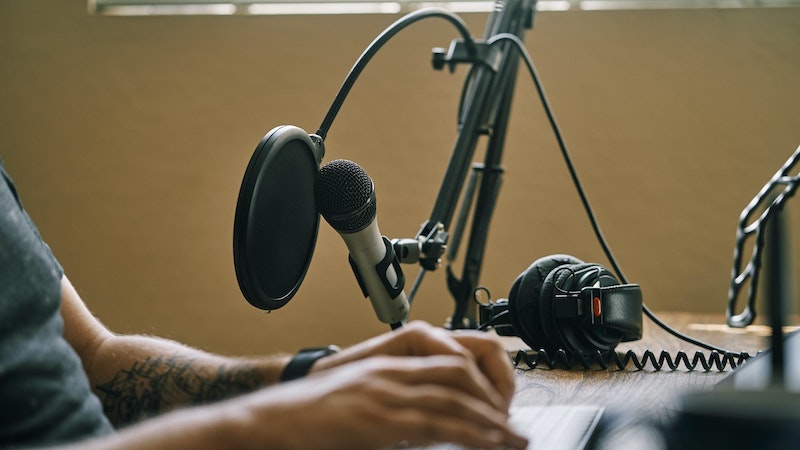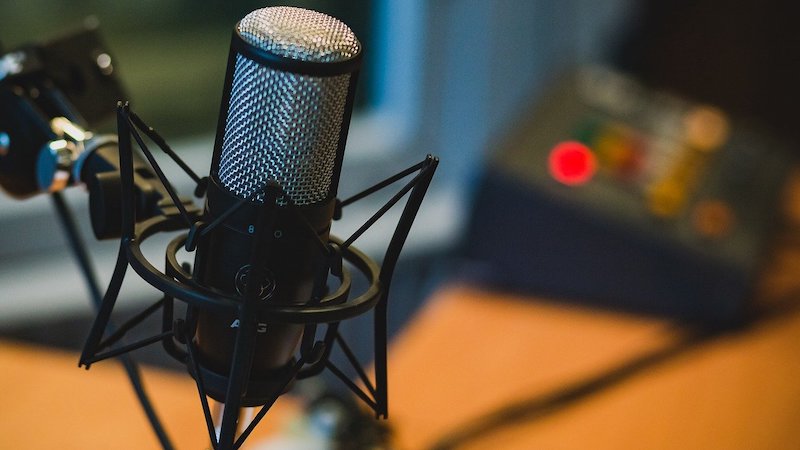The video editor for podcasters Get unlimited 15-second videos for free
Podcast Guide for Beginners: What Do I Need to Get Started?
Starting a podcast might seem overwhelming at first. What equipment do you need? How should you promote your podcast? In this guide, we’ll look at the basic tools you need to start a successful podcast.
What is the best microphone? What editing software should you use? Where can you best promote your podcast? With so many decisions to make, starting a podcast can seem overwhelming at first.
The good news is that launching a podcast doesn’t require a lot of equipment or expensive technology, so you don’t need a lot in order to get started. Actually, when first getting started with a podcast, there are only three key factors you need to focus on: your microphone, your editing software, and your promotion strategy.
In this guide, we will look closely at all three factors and give you tips on how to get started on your podcast.
How to pick the right microphone
Even though headphones, mixers and of course your computer are all essential to creating a podcast with a high sound quality, the most important piece of equipment you should focus on first is the microphone.
Your microphone will affect your audio quality more than any other tool you choose for your podcast. In other words: If you pick the wrong microphone or are using your microphone incorrectly, not even the best editing software will be able to fix things later on. And no matter how interesting the content of your podcast might be, listeners will not stick around if the sound quality is bad.
So how do you go about picking the best microphone?
Dynamic microphone vs. condenser microphone
Generally speaking, there are two types of microphones: dynamic mics and condenser microphones. Dynamic microphones are considered good all-around mics that deliver a decent sound quality without being too sensitive when it comes to picking up unwanted breathing or pops. They are also reasonably cheap and sturdy.
Condenser microphones, on the other hand, are a lot more sensitive and they are more susceptible to distorting the sound at higher levels. That being said, they deliver a clearer, more natural and more transparent sound, which is why most podcasters prefer condenser microphones for recording voice.
As they are sensitive to picking up background noises or pop sounds from speaking, we recommend using them in conjunction with a pop shield filter that you place between your mouth and the microphone.
Generally speaking, if your podcast format just consists of you talking to your audience, a condenser microphone is the best choice. This is also true if you have guests on your podcast. If you have guests though, make sure that each person has their own microphone, because sharing microphones can cause several problems.
If you just use one mic, there might be unpleasant noises as you shift it from person to person. Or, if you choose to position the mic in the middle, neither person will be at an optimal angle to speak into it, so neither person will sound completely clear on the recording.
When you should consider using a dynamic mic
So, while in most cases, a condenser microphone is the better choice, if you do a lot of reporting where background noise is important for the atmosphere, you might prefer using a dynamic mic. Dynamic mics are better at picking up atmospheric sounds and nuances.
So, if for example, you want to convey the atmosphere at a music festival or at a sports event or even just background noises in a specific location such as a café, working with a dynamic mic will yield better results. Or if you plan on doing a lot of reporting outside and capturing the background noise is important, it might be worth considering investing in a dynamic mic. Since they are fairly affordable, it won’t break your bank.
Additional microphone tools
Once you have chosen a good microphone, you might consider adding a few additional tools to help you improve the sound quality even further. They are not totally necessary and you can definitely get started without them, but these tools can help give you even better audio quality for your podcast.
One of these tools is, as already mentioned, a pop shield filter. Pop shield filters shield the microphone from the strong plosives we produce when we speak. The letter “p” especially, but the letter “b” also tends to make a strong popping sound in recording. In addition, “s”, “th,” and “f” sounds tend to sound unpleasant when recorded with condenser mics.
While in normal conversation you won’t notice these sounds, in recordings, they sound very strong, so investing in a pop shield filter is probably worth it.
If you are doing a lot of mobile reporting, there are also small pop shield filters for portable microphones that you can use to improve the recording quality.
What to consider when picking an editing software
After your microphone, your editing software is probably the second most important piece of technology for starting a podcast. It will help you edit your recordings and organize them into engaging podcast episodes.
Three of the most popular editing programs used by podcasters are Audacity, Garage Band, and Adobe Audition.
Audacity
Audacity is an open source editing program, so it’s completely free. It also offers everything you need for editing when first starting a podcast. However, its design is somewhat antiquated, and might not be very intuitive at first.
Garage Band
If you use an Apple computer for your podcast, Garage Band is a great option. It might have more features than you need for just editing voice, as it was originally designed for editing instruments and music. However, it is very convenient if you already work with a Mac.
It allows you to cut and edit audio very easily, move sections around, and also layer sound. It’s easy enough to use that it is a great editing software for podcast beginners.
Adobe Audition
Adobe Audition is also a great choice for editing audio for your podcast. However, the real strength of Audition is that it will greatly help you with your workflow beyond editing.
For instance, if you have an audio clip that you would like to use as a teaser on social media, you can simply grab it from the software program and share it in your social feeds.
However, Adobe Audition is fairly expensive. If you are just starting out, it might not be worth paying for it unless you have a reason to get the larger Adobe Suite.
Our tip: If you have never used editing software before, we would recommend starting with a simpler program such as Audacity to get a feel for audio editing. Depending on the podcast, you might not even need anything fancier, or you might decide that it’s worth investing in a more advanced editing software.
Promoting your podcast
Few people think about marketing as a podcast essential when they are starting out. The truth is, though, that your podcast can only be successful if people tune in, and in order for people to tune in to your podcast, you have to let them know about it.
There are, of course, several ways to promote your podcast. Aside from getting your podcast on one or several of the main podcast registries, it’s also worth putting some effort into other forms of online marketing.
Blog
If you already have a blog that ties in with your podcast theme, don’t hesitate to promote your podcast there.
Promoting your podcast on a website such as a blog will not only help your readers find your podcast, but it will also allow your podcast to appear in search results on Google.
This is a huge opportunity for your podcast to be found outside the typical podcast registries and can help you to gain a lot of listeners.
Social Media
If you don’t have a blog and don’t want to start one for your podcast, promoting your podcast on social media is another great option to get the word out about your podcast. Even if you do have a blog where you talk about your podcast, you should definitely still promote it on social media.
All social media platforms offer various opportunities and tools to promote your podcast.
Create TikTok videos
You could, for example, create engaging TikTok videos around your podcast. If you think that TikTok only has silly dance videos and is merely used by teenagers, you are disregarding that in the past year, the platform has become more popular with an older audience, and there is also an increase in serious content on TikTok. So, it’s worth giving it a try.
There are many ways in which you could promote your podcast on TikTok. You could share short video clips that your record with your podcast guests. Or, you could record some behind the scenes impressions, and share those with your followers.
or share some behind the scenes impressions with your followers.
You could also share short video teasers about upcoming episodes to get people to tune in to your podcast.
Instagram Stories
Instagram Stories has over 500 million daily users, so it’s the perfect social media platform to promote your podcast to a large number of people. Since stories are meant to be short, current, and to the point, they are an ideal format for promoting new podcast episodes.
If you have a verified account, you can even include a link to your podcast in a story.
A very helpful tool for not only creating but also scheduling Instagram Stories is Storrito. The web tool can be used on a smartphone or tablet, but also on a desktop PC, and it allows you to schedule posts even weeks in advance. So, it makes promoting your podcast on Instagram Stories really easy.
Sharing your podcast on YouTube
YouTube is primarily a social media platform for video content. However, there is also a lot of audio content on YouTube. In fact, many podcast creators turn their recordings into videos to give a wider audience easy access to their content.
Because not everybody uses podcast apps, uploading your podcast episodes to YouTube allows you to reach an audience that otherwise might not have tuned in.
This strategy can be very successful. The movie podcast How Did This Get Made, for example, regularly uploads their episodes to YouTube and many of their videos have thousands of views.
Audiograms
If you are wondering how to make sure that a post about your podcast will stand out on social media, audiograms are the way to go.
Audiograms combine an audio clip from your podcast with an image and the audio wave form to create a short video.
Both the unusual format and the video content of the audiograms pique people’s interest as they are scrolling through their social media feeds.
Even if you are just starting out with your podcast, you won’t find it hard to create audiograms. Web tools such as Audiocado make it very easy. It only takes a few minutes to come up with a creative audiogram that will capture people’s attention on social media.
Try it out for free now, and see how it can take your podcast to the next level!


